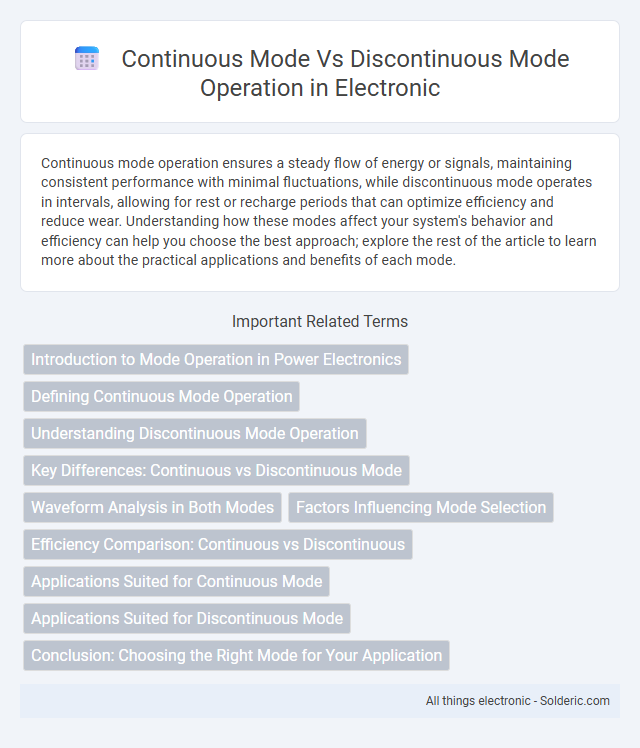Continuous mode operation ensures a steady flow of energy or signals, maintaining consistent performance with minimal fluctuations, while discontinuous mode operates in intervals, allowing for rest or recharge periods that can optimize efficiency and reduce wear. Understanding how these modes affect your system's behavior and efficiency can help you choose the best approach; explore the rest of the article to learn more about the practical applications and benefits of each mode.
Comparison Table
| Feature | Continuous Mode | Discontinuous Mode |
|---|---|---|
| Operation | Constant current flow | Intermittent current flow with start-stop intervals |
| Current Ripple | Low ripple, steady output | Higher ripple, fluctuating output |
| Efficiency | Higher efficiency at higher loads | Better efficiency at light loads |
| Inductor Current | Never falls to zero | Falls to zero before next cycle |
| Application | High-power converters, steady load | Low-power converters, varying load |
| Control Complexity | More complex control needed | Simpler control schemes possible |
| Output Voltage Stability | Higher stability | Lower stability due to ripple |
Introduction to Mode Operation in Power Electronics
Mode operation in power electronics defines how a converter manages energy transfer between input and output during switching cycles. Continuous mode operation maintains current flow through the inductor without dropping to zero, ensuring steady energy delivery and reduced ripple. Discontinuous mode occurs when inductor current falls to zero before the next switching cycle, improving efficiency at light loads but increasing current ripple and electromagnetic interference.
Defining Continuous Mode Operation
Continuous mode operation refers to a system or device functioning without interruption over an extended period, maintaining stable output and performance under constant input conditions. In power electronics, this mode ensures the inductor current never falls to zero during the switching cycle, optimizing energy transfer efficiency and reducing electromagnetic interference. Continuous mode operation enhances system reliability in applications like DC-DC converters, where steady current flow is crucial for maintaining voltage regulation and minimizing ripple.
Understanding Discontinuous Mode Operation
Discontinuous Mode Operation occurs in power converters when the inductor current drops to zero during part of the switching cycle, leading to intervals with no energy transfer. This mode is common at light loads, resulting in reduced conduction losses but increased ripple and potential noise in the output voltage. Understanding Discontinuous Mode is crucial for optimizing your converter's efficiency and ensuring stable performance across varying load conditions.
Key Differences: Continuous vs Discontinuous Mode
Continuous Mode operation maintains a steady conduction of current throughout the entire switching cycle, ensuring minimal ripple and improved efficiency in power converters. Discontinuous Mode, in contrast, involves intervals where the current falls to zero before the next switching cycle begins, reducing switching losses but increasing output ripple. Key differences revolve around current flow continuity, efficiency trade-offs, and ripple characteristics, with Continuous Mode favoring stable output and Discontinuous Mode benefiting light-load efficiency.
Waveform Analysis in Both Modes
Continuous mode operation exhibits a steady-state waveform with consistent amplitude and frequency, allowing for stable signal analysis and minimal distortion. In contrast, discontinuous mode operation produces intermittent waveforms characterized by gaps or pulses, resulting in variable amplitude and frequency that require specialized filtering techniques to accurately interpret. Analyzing waveforms in both modes involves examining duty cycle, peak voltage, and harmonic content to optimize performance in power electronics and communication systems.
Factors Influencing Mode Selection
Factors influencing the selection between continuous mode and discontinuous mode operation include load demand, efficiency requirements, and system complexity. Continuous mode suits applications with steady, high power loads, ensuring consistent energy delivery and minimal ripple, while discontinuous mode benefits low-load conditions by reducing switching losses and improving efficiency. Design constraints such as component size, thermal management, and electromagnetic interference also play critical roles in determining the optimal operation mode.
Efficiency Comparison: Continuous vs Discontinuous
Continuous mode operation generally offers higher efficiency due to steady inductor current, minimizing switching and conduction losses. Discontinuous mode operation reduces core losses at light loads by allowing the inductor current to drop to zero, enhancing efficiency in low-power conditions. Efficiency optimization depends on load range, with continuous mode preferred for higher loads and discontinuous mode beneficial for light-load energy savings.
Applications Suited for Continuous Mode
Continuous mode operation is ideal for applications requiring stable and uninterrupted power supply, such as communication systems, medical devices, and industrial automation. Your equipment benefits from consistent voltage output and reduced electromagnetic interference, ensuring reliable performance in critical environments. This mode supports high-efficiency power conversion, making it suitable for devices with steady load conditions and stringent quality requirements.
Applications Suited for Discontinuous Mode
Discontinuous mode operation is ideal for applications requiring low power consumption and intermittent load conditions, such as battery-powered devices and portable electronics. This mode enhances efficiency by allowing the inductor current to fall to zero before the next switching cycle begins, reducing switching losses and electromagnetic interference. Your device can benefit from improved thermal management and extended battery life when operating in discontinuous mode under varying load demands.
Conclusion: Choosing the Right Mode for Your Application
Continuous mode offers steady power delivery ideal for applications requiring consistent performance and minimal fluctuations, while discontinuous mode enhances efficiency in low-load scenarios by reducing switching losses. Your choice depends on the specific power demands and efficiency priorities of your application, balancing reliability with energy savings. Evaluating load conditions and thermal constraints ensures selecting the most suitable mode for optimal operation.
Continuous Mode vs Discontinuous Mode Operation Infographic

 solderic.com
solderic.com